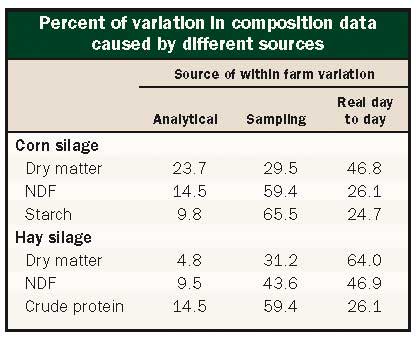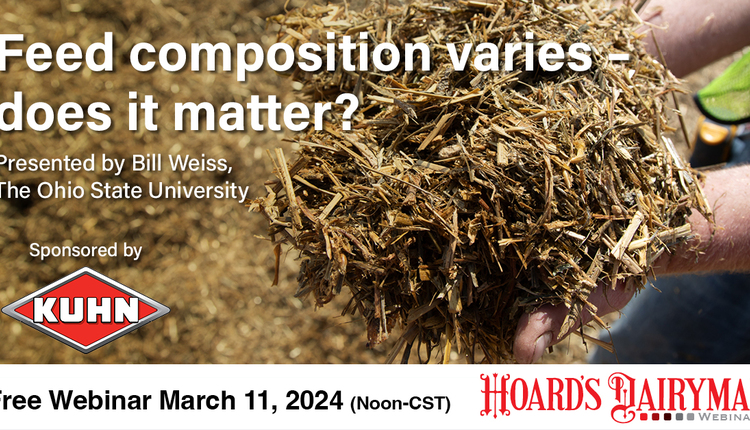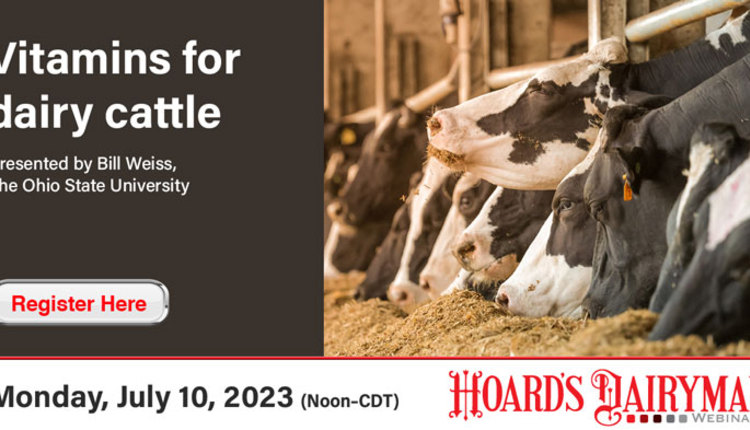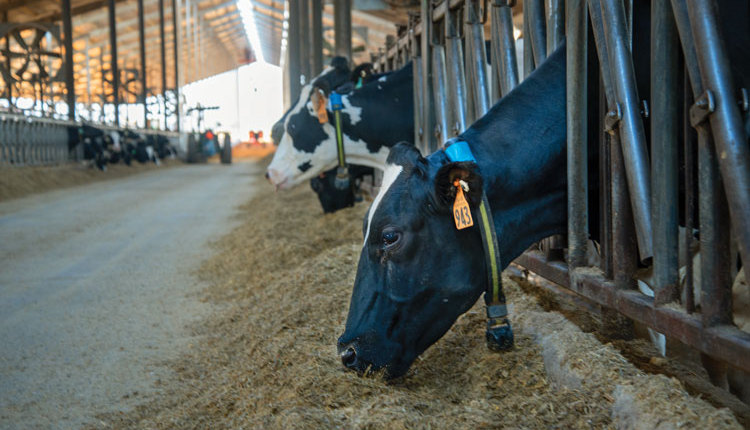The authors are professors in the animal science department at The Ohio State University.

Since sound feed composition data is so important to overall dairy farm profitability, we need to ensure that the information we have accurately reflects the feed we're using.
If you harvest 1,000 tons of corn silage and sample it throughout the feeding period, you will most likely find a range of values for dry matter (DM), crude protein (CP), fiber (NDF), starch and minerals. We need to understand what caused the values to change, and then we decide what to do when they change. Your decision regarding what to do when composition apparently changed is dependent upon the reason for the change.
Why does it change?
There are three reasons why composition values vary among samples of a feed: analytical variation, sampling variation and what we call real variation. If you analyze a single sample multiple times or sent subsamples to different labs, the variation among results is called analytical variation. This variation may be caused by human error or variation in reaction conditions. Good labs use protocols that usually result in low analytical variation.
If you take multiple samples from a pile of silage, the variation among the samples is sampling variation. When we sample feeds, we are sampling particles, not nutrients. If all the particles have similar nutrient composition, then sampling variation will be very small, but if the particles differ in composition, sampling variation can be large.
Corn silage consists of pieces of grain, cob, stalk and leaves, and the nutrient composition of these pieces is quite different. We expect sampling variation for feeds like soybean meal to be much less than it is for corn silage. Real variation can be caused by different hybrids of corn silage, different growing conditions or rain events on exposed silage.
We conducted an experiment in which corn silage and hay silage were sampled daily from multiple dairy farms over a 14-day period. On each day, two samples of each silage were taken. Samples were analyzed in duplicate for DM, NDF, CP and starch using standard wet chemistry methods in our lab, hence lab-to-lab variation was not an issue.
With duplicate assays and samples across multiple days, we could partition the variation into analytical, sampling and real day-to-day changes (see table). For all nutrients from both types of silage, analytical variation was the smallest contributor to total within farm variation and usually was less than 10 percent of the total variation.
For CP, NDF and starch, sampling error was usually the largest source of variation. In many cases, sampling error was more than twice as great as true day-to-day variation. For both silages, real day-to-day variation was the major source of variation for DM concentration.
In another project, we sampled corn and alfalfa silages monthly over a year on multiple dairy farms. We found that true month-to-month variation over a year was about twice as large as true day-to-day variation over a 14-day period. But, even over a 12-month period, sampling plus analytical variation accounted for about 50 percent of the total within farm variation for NDF concentration in corn silage and CP concentration in alfalfa silage.

Why should you care?
The very large contribution sampling makes to within farm variation has important ramifications for ration formulation. First, high sampling variation means that a single sample of a silage is probably not very accurate; the average of multiple samples is needed to obtain an accurate nutrient description of the silage.
Second, high sample variation means that very often what appears to be a change in silage composition actually is not. A nutritionist may reformulate a diet because of an apparent change in forage composition when the silage actually did not change. This reformulation could result in a poorly balanced diet, a loss in milk yield or health problems.
For example, if silage NDF "apparently" changed from 38 percent to 44 percent, the amount of forage in the diet may be reduced to maintain the desired amount of fiber in the diet. If the silage really did not change though, the new diet may actually be deficient in NDF resulting in acidosis.
What can be done?
Sampling error can be eliminated by using a protocol that results in perfectly representative samples. Although this is likely an unobtainable goal, sampling techniques often can be improved. Sampling procedures that result in samples with different particles will enhance sampling variation if the different particles have different nutrient composition.
The face of a bunker silo should never be sampled directly because it can result in a biased sample (plus the real risk of getting killed by a silage avalanche). When pulling a handful of silage from a face of a bag or bunker silo, longer pieces (for example, alfalfa stems or corn leaves) can be stuck in the silage mass, and the handful of silage you pull away will be enriched with smaller particles.
The smaller particles can have a very different nutrient composition than larger particles. Removing a sample with your palm facing down allows smaller particles to drop away which will enrich your sample with larger particles. Sampling protocols should be evaluated, and practices that allow loss of specific particles should be avoided.
The other way sampling error can be eliminated is to take multiple samples and average the results. This will raise analytical costs but will reduce the risk of formulating a bad diet. Although we have not conducted the research, the mean of duplicate samples will likely be adequate on most farms. On one farm, duplicate sampling reduced the variation by 50 percent. A single sample could have been more than 5 NDF percentage units from the mean, whereas the average of duplicate samples was never more than 3 percentage units from the mean.
Good samples are the cornerstone of good diet formulation. If sampling technique is poor and the uncertainty surrounding feed composition data is expressed as plus or minus several percentage units, using nutritional models that formulate diets to the tenth decimal place will not result in well-formulated, consistent diets. Good SOPs for sampling should be developed and followed. Multiple samples of feeds should be taken to monitor sampling variation, and averages of composition data should be used rather than data from a single sample to reduce the impact of improper sampling.
Click here to return to the Nutrition E-Sources 150525_126

Since sound feed composition data is so important to overall dairy farm profitability, we need to ensure that the information we have accurately reflects the feed we're using.
If you harvest 1,000 tons of corn silage and sample it throughout the feeding period, you will most likely find a range of values for dry matter (DM), crude protein (CP), fiber (NDF), starch and minerals. We need to understand what caused the values to change, and then we decide what to do when they change. Your decision regarding what to do when composition apparently changed is dependent upon the reason for the change.
Why does it change?
There are three reasons why composition values vary among samples of a feed: analytical variation, sampling variation and what we call real variation. If you analyze a single sample multiple times or sent subsamples to different labs, the variation among results is called analytical variation. This variation may be caused by human error or variation in reaction conditions. Good labs use protocols that usually result in low analytical variation.
If you take multiple samples from a pile of silage, the variation among the samples is sampling variation. When we sample feeds, we are sampling particles, not nutrients. If all the particles have similar nutrient composition, then sampling variation will be very small, but if the particles differ in composition, sampling variation can be large.
Corn silage consists of pieces of grain, cob, stalk and leaves, and the nutrient composition of these pieces is quite different. We expect sampling variation for feeds like soybean meal to be much less than it is for corn silage. Real variation can be caused by different hybrids of corn silage, different growing conditions or rain events on exposed silage.
We conducted an experiment in which corn silage and hay silage were sampled daily from multiple dairy farms over a 14-day period. On each day, two samples of each silage were taken. Samples were analyzed in duplicate for DM, NDF, CP and starch using standard wet chemistry methods in our lab, hence lab-to-lab variation was not an issue.
With duplicate assays and samples across multiple days, we could partition the variation into analytical, sampling and real day-to-day changes (see table). For all nutrients from both types of silage, analytical variation was the smallest contributor to total within farm variation and usually was less than 10 percent of the total variation.
For CP, NDF and starch, sampling error was usually the largest source of variation. In many cases, sampling error was more than twice as great as true day-to-day variation. For both silages, real day-to-day variation was the major source of variation for DM concentration.
In another project, we sampled corn and alfalfa silages monthly over a year on multiple dairy farms. We found that true month-to-month variation over a year was about twice as large as true day-to-day variation over a 14-day period. But, even over a 12-month period, sampling plus analytical variation accounted for about 50 percent of the total within farm variation for NDF concentration in corn silage and CP concentration in alfalfa silage.

Why should you care?
The very large contribution sampling makes to within farm variation has important ramifications for ration formulation. First, high sampling variation means that a single sample of a silage is probably not very accurate; the average of multiple samples is needed to obtain an accurate nutrient description of the silage.
Second, high sample variation means that very often what appears to be a change in silage composition actually is not. A nutritionist may reformulate a diet because of an apparent change in forage composition when the silage actually did not change. This reformulation could result in a poorly balanced diet, a loss in milk yield or health problems.
For example, if silage NDF "apparently" changed from 38 percent to 44 percent, the amount of forage in the diet may be reduced to maintain the desired amount of fiber in the diet. If the silage really did not change though, the new diet may actually be deficient in NDF resulting in acidosis.
What can be done?
Sampling error can be eliminated by using a protocol that results in perfectly representative samples. Although this is likely an unobtainable goal, sampling techniques often can be improved. Sampling procedures that result in samples with different particles will enhance sampling variation if the different particles have different nutrient composition.
The face of a bunker silo should never be sampled directly because it can result in a biased sample (plus the real risk of getting killed by a silage avalanche). When pulling a handful of silage from a face of a bag or bunker silo, longer pieces (for example, alfalfa stems or corn leaves) can be stuck in the silage mass, and the handful of silage you pull away will be enriched with smaller particles.
The smaller particles can have a very different nutrient composition than larger particles. Removing a sample with your palm facing down allows smaller particles to drop away which will enrich your sample with larger particles. Sampling protocols should be evaluated, and practices that allow loss of specific particles should be avoided.
The other way sampling error can be eliminated is to take multiple samples and average the results. This will raise analytical costs but will reduce the risk of formulating a bad diet. Although we have not conducted the research, the mean of duplicate samples will likely be adequate on most farms. On one farm, duplicate sampling reduced the variation by 50 percent. A single sample could have been more than 5 NDF percentage units from the mean, whereas the average of duplicate samples was never more than 3 percentage units from the mean.
Good samples are the cornerstone of good diet formulation. If sampling technique is poor and the uncertainty surrounding feed composition data is expressed as plus or minus several percentage units, using nutritional models that formulate diets to the tenth decimal place will not result in well-formulated, consistent diets. Good SOPs for sampling should be developed and followed. Multiple samples of feeds should be taken to monitor sampling variation, and averages of composition data should be used rather than data from a single sample to reduce the impact of improper sampling.










